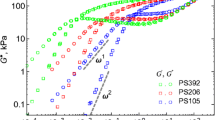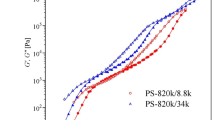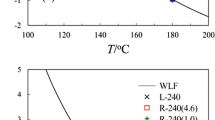Abstract
We present start-up of uniaxial extension followed by stress relaxation experiments of a bi-disperse 50 % by weight blend of 95k and 545k molecular weight polystyrene. We also show, for comparison, stress relaxation measurements of the polystyrene melts with molecular weight 95k and 545k, which are the components of the bi-disperse melt. The measurements show three separated relaxation regimes: a fast regime, a transition regime, and a slow regime. In the fast regime, the orientation of the long chains is frozen and the stress relaxation is due to stretch relaxation of the short chains primarily. Conversely in the slow regime, the long chains have retracted and undergo relaxation of orientation in fully relaxed short chains.












Similar content being viewed by others

References
Auhl D, Chambon P, McLeish T C B, Read D J (2009) Elongational flow of blends of long and short polymers: effective stretch relaxation time. Phys Rev Lett 136001:103
Andreev M, Khaliullin R N, Steenbakkers R J A, Schieber J D (2013) Approximations of the discrete slip-link model and their effect on nonlinear rheology predictions. J Rheol 57(2):535–557
Bach A, Almdal K, Rasmussen H K, Hassager O (2003a) Elongational viscosity of narrow molar mass distribution polystyrene. Macromolecules 36:5174–5179
Bach A, Rasmussen H K, Hassager O (2003b) Extensional viscosity for polymer melts measured in the filament stretching rheometer. J Rheol 47(2):429–441
Baumgaertel M, Schausberger A, Winter H H (1990) The relaxation of polymers with linear flexible chains of uniform length. Rheol Acta 29:400–408
des Cloizeaux J (1988) Double reptation vs. simple reptation in polymer melts. J Europhys Lett 5:437–432
de Gennes P G (1975) Dynamics of entangled polymer solutions. II Inclusion of hydrodynamic interactions. Macromolecules 9:594–598
Doi M, Edwards S F (1986) The theory of polymer dynamics. Clarendon Press, Oxford
Hayes C, Bokobza L, Boué F, Mendes E, Monnerie L (1996) Relaxation dynamics in bimodal polystyrene melts: a Fourier-transform infrared dichroism and small-angle neutron scattering study. Macromolecules 29:5036–5041
Huang Q, Alvarez N J, Matzumiya Y, Rasmussen H K, Watanabe H, Hassager O (2013a) Extensional rheology of entangled polystyrene solutions suggests importance of nematic interaction. ACS Macro Letters 2:741–744
Huang Q, Mednova O, Rasmussen H K, Alvarez N J, Skov A L, Almdal K, Hassager O (2013b) Concentrated polymer solutions are different from melts: role of entanglement molecular weight. Macromolecules 46:5026–5035
Ianniruberto G, Brasiello A, Marrucci G (2012) Simulations of fast shear flows of PS oligomers confirm monomeric friction reduction in fast elongational flows of monodisperse PS melts as indicated by rheo-optical data. Macromolecules 45:8058–8066
Likhtman A E, McLeish T C B (2002) Quantitative theory for linear dynamics of linear entangled polymers. Macromolecules 35:6332–6343
Khaliullin R N, Schieber J D (2010) Application of the Slip-link Model to Bidisperse Systems. Macromolecules 43(14):6201–6212
Kolte M I, Rasmussen H K, Hassager O (1997) Transient filament stretching rheometer: II Numerical simulation. Rheol Acta 36(3):285–302
Kornfield J. A., Fuller G., Pearson D. S. (1989) Infrared dichroism measurements of molecular relaxation in binary blend melt rheology. Macromolecules 22:1334–1345
Lee J H, Fetters L J, Archer L A, Halasa A F (2005) Tube dynamics in binary polymer blends. Macromolecules 38:3917–3932
Lyhne A, Rasmussen H K, Hassager O (2009) Simulation of elastic rupture in extension of entangled monodisperse polymer melts. Phys Rev Lett 102(138301)
Marrucci G (1985) Relaxation by reptation and tube enlargement: a model for polydisperse polymers. J Polym Sci Polym Phys Ed 23:159–177
Milner S T, McLeish T C B (1998) Reptation and Contour-Length fluctuations in melts of linear polymers. Phys Rev Lett 81:725–728
Ndoni S, Papadakis C M, Bates F S, Almdal K (1995) Laboratory-scale setup for anionic polymerization under inert atmosphere. Rev Sci Instrum 66:1090–1095
Nielsen J K, Rasmussen H K, Hassager O, McKinley G H (2006) Elongational viscosity of monodisperse and bi-disperse polystyrene melts. J Rheol 50:453–476
Nielsen J K, Rasmussen H K, Hassager O (2008) Stress relaxation of narrow molar mass distribution polystyrene following uniaxial extension. J Rheol 52(4):885–899
Park S J, Larson R G (2004) Tube dilation and reptation in binary blends of monodisperse linear polymers. Macromolecules 37:597–604
Rasmussen H K, Bejenariu A G, Hassager O, Auhl D J (2010) Experimental evaluation of the pure configurational stress assumption in the flow dynamics of entangled polymer melts. J Rheol 54(6):1325–1336
Rasmussen H K (2014) Interchain tube pressure effect in the flow dynamics of bi-disperse polymer melts. Rheol Acta 54:9–18
Read D J, Jagannathan K, Sukumaran S K, Auhl D (2012) A full-chain constitutive model for bidisperse blends of linear polymers. J Rheol 56:823–873
Román Marín J M, Huusom J K, Alvarez N J, Huang Q, Rasmussen H K, Bach A, Skov A L, Hassager O (2013) A control scheme for filament stretching rheometers with application to polymer melts. J Non-Newtonian Fluid Mech 194:14–22
Szabo P (1997) Transient filament stretching rheometer part: I Force balance analysis. Rheol Acta 36:277–284
Szabo P, McKinley G H (2003) Filament stretching rheometer: inertia compensation revisited. Rheol Acta 42:269–271
Struglinski M J (1985) WWGRaessley. Effect of polydispersity on the linear viscoelastic properties of entangled polymers. 1. Experimental observation for binary mixtures of linear polybutadiene, Macromolecules 18:2630–2643
Struglinski M J, Graessley W W (1986) Effect of polydispersity on the linear viscoelastic properties of entangled polymers. 2. Comparison of viscosity and recoverable compliance with tube model predictions. Macromolecules 19:1754–1760
Tsenoglou C (1987) Viscoelasticity of binary polymer blends. ACS Polym Preprints 28:185–186
van Ruymbeke E, Masubuchi Y, Watanabe H (2012) Effective value of the dynamic dilution exponent in bidisperse linear polymers: from 1 to 4/3. Macromolecules 45:2085–2098
van Ruymbeke E, Nielsen J, Hassager O (2010) Linear and nonlinear viscoelastic properties of bidisperse linear polymers: mixing law and tube pressure effect. J Rheol 54(5):1155–1172
van Ruymbeke E, Shchetnikava V, Matsumiya Y, Watanabe H (2014) Dynamic dilution effect in binary blends of linear polymers with well-separated molecular weights. Macromolecules 47:7653–7665
Wagner M H, Kheirandish S, Koyama K, Nishioka A, Minegishi A, Takahashi T (2005) Modelling strain hardening of polydisperse polystyrene melts by molecular by molecular stress function theory. Rheol Acta 44:235–243
Wagner M (2011) The effect of dynamic tube dilation on chain stretch in nonlinear polymer melt rheology. J of Non-Newtonian Fluid Mech 166:915–924
Wang Y, Boukany P, Wang S Q, Wang X (2007) Elastic breakup in uniaxial extension of entangled polymer melts. Phys Rev Lett 237801:99
Watanabe H, Ishida S, Matzumiya Y, Inoue T (2004a) Viscoelastic and dielectric behavior of entangled blends of linear polyisoprenes having widely separated molecular weights: test of tube dilation picture. Macromolecules 37:1937–1951
Watanabe H, Ishida S, Matzumiya Y, Inoue T (2004b) Test of full and partial tube dilation pictures in entangled blends of linear polyisoprenes. Macromolecules 37:6619–6631
Watanabe H, Matzumiya Y, Ruymbeke E V (2013) Component relaxation times in entangled binary blends of linear chains: reputation/CLF along partially or fully dilated tube. Macromolecules 46:9296–9312
Yaoita T, Takeharu I, Masubuchi Y, Watanabe H, Ianniruberto G, Marrucci G (2012) Primitive chain network simulation of elongational flows of entangled linear chains: stretch/orientation-induced reduction of monomeric friction. Macromolecules 45:2773–2782
Acknowledgments
The research leading to these results has received funding from the Danish Council for Independent Research - Natural Sciences under EPMEF on Grant 0602-02179B, and Aage og Johanne Louis-Hansens Fond. We would like to thank the anonymous reviewers for constructive observations and suggestions.
Author information
Authors and Affiliations
Corresponding author
Rights and permissions
About this article
Cite this article
Hengeller, L., Huang, Q., Dorokhin, A. et al. Stress relaxation of bi-disperse polystyrene melts. Rheol Acta 55, 303–314 (2016). https://doi.org/10.1007/s00397-016-0916-9
Received:
Revised:
Accepted:
Published:
Issue Date:
DOI: https://doi.org/10.1007/s00397-016-0916-9



